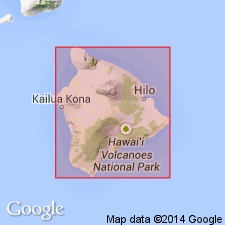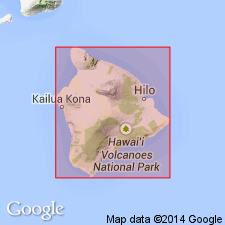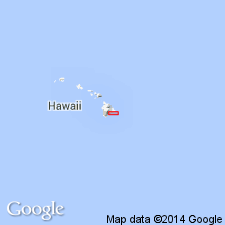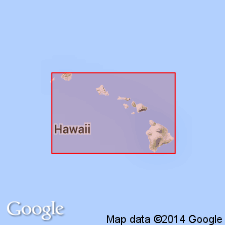
- Usage in publication:
-
- Pohakaa Member
- Modifications:
-
- Named
- Dominant lithology:
-
- Ash
- AAPG geologic province:
-
- Hawaii
Summary:
Stratigraphic column shows unit to be 2nd youngest member (of 4) of Hilina Formation on S flank of Kilauea Volcano, Island of Hawaii. Underlies Moo Member (new); overlies Kahele Member (new). Informally subdivided into upper, middle, and lower beds. Assigned 50,000(?) yr B.P. estimated on projected lava accumulation rate. [Note for information on name and type section see Easton (1987)]
Source: GNU records (USGS DDS-6; Menlo GNULEX).

- Usage in publication:
-
- Pohakaa Member
- Modifications:
-
- Age modified
- AAPG geologic province:
-
- Hawaii
Summary:
Pyroclastic unit named by Easton and Garcia (1980) is 2nd youngest member (of 4) of Hilina Formation. Covers area of approx. 1000 sq km. Comprises as many as 6 pyroclastic layers of vitric ash, palagonite, and soil ranging in thickness from 1 to 4 m, separated by intercalated lava flows --some layers contain abundant lithic and crystal fragments and appear to be pyroclastic-surge deposits. Has estimated cumulative thickness of 15 m. Assigned age of approx. 50,000(?) to 40,000 yr B.P.
Source: GNU records (USGS DDS-6; Menlo GNULEX).

- Usage in publication:
-
- Pohakaa Ash Member*
- Modifications:
-
- Redescribed
- Overview
- AAPG geologic province:
-
- Hawaii
Summary:
Name changed to reflect lithology and volcanic origin of 2nd youngest member of Hilina Basalt. Name derived from Hawaiian god (Kulakaua, 1888). Type section at Pohakaa Arroyo (approx 425-450 m elev) (19 deg 16' 40"N, 155 deg 20' 00"W, Kau Desert 7.5' quad) [on south slope of Kilauea Volcano, Island of Hawaii, HI]. Reference section at Puu Kapukapu (19 deg 16' 45"N, 155 deg 15' 35"W, Kau Desert 7.5' quad). Measured section with description of beds at Keana Bihopa. Informally subdivided into 3 beds. Tree molds of METROSIDERUS sp. (Ohia lehua) in flows overlying middle bed imply humid climate during deposition. Age is not known. However member is older than Pahala Ash. 50 to 40 ka age estimated on lava and ash accumulation rates (Easton, 1987).
Source: GNU records (USGS DDS-6; Menlo GNULEX).

- Usage in publication:
-
- Pohakaa Ash Member*
- Modifications:
-
- Redescribed
- AAPG geologic province:
-
- Hawaii
Summary:
Name changed to Pohakaa Ash Member to show lithology. Type locality in Pohakaa Arroyo, about 3 km southwest of Keana Bihopa. Reference locality at Puu Kapukapu. Assigned Pleistocene age. [see Easton, 1987, this vol.]
Source: GNU records (USGS DDS-6; Menlo GNULEX).
For more information, please contact Nancy Stamm, Geologic Names Committee Secretary.
Asterisk (*) indicates published by U.S. Geological Survey authors.
"No current usage" (†) implies that a name has been abandoned or has fallen into disuse. Former usage and, if known, replacement name given in parentheses ( ).
Slash (/) indicates name conflicts with nomenclatural guidelines (CSN, 1933; ACSN, 1961, 1970; NACSN, 1983, 2005, 2021). May be explained within brackets ([ ]).

